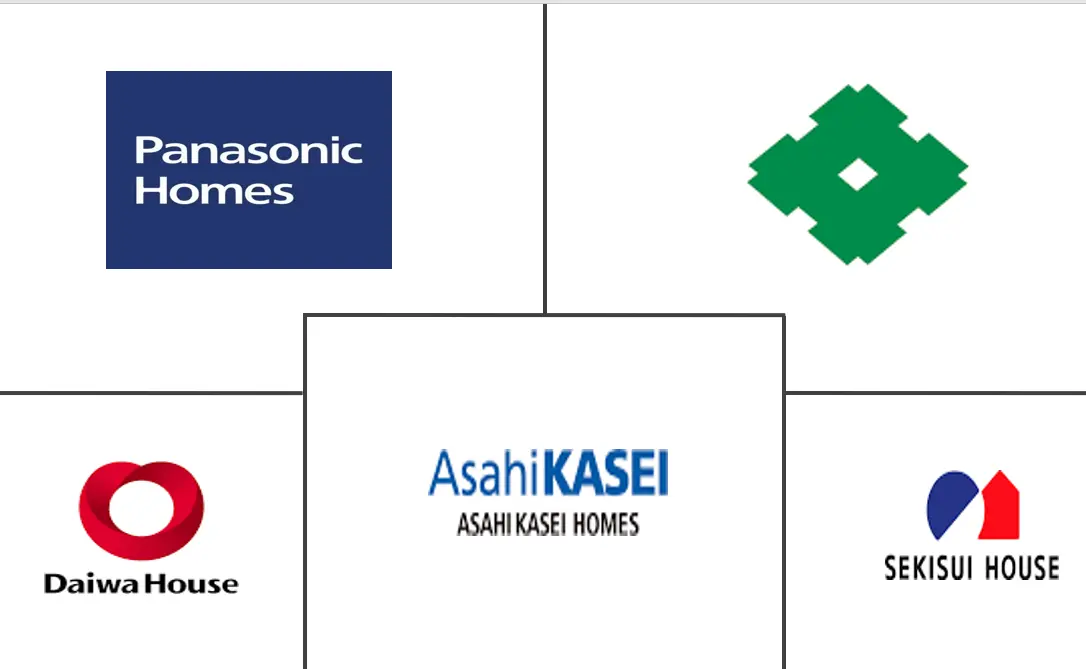Market Size of Japan Residential Construction Industry

| Study Period | 2020 - 2029 |
| Base Year For Estimation | 2023 |
| Forecast Data Period | 2024 - 2029 |
| Historical Data Period | 2020 - 2022 |
| CAGR | 5.00 % |
| Market Concentration | Medium |
Major Players
*Disclaimer: Major Players sorted in no particular order |
Japan Residential Construction Market Analysis
The Japan residential construction market is valued at about USD 263.66 billion and is expected to register a CAGR of more than 5% during the forecast period.
The Japanese residential construction market is anticipated to register a CAGR of greater than 5% during the forecast period.
The COVID-19 pandemic has caused the construction of residential properties to be halted in Japan. This slowed the growth of the residential construction market in 2020, but it was picking up in 2021 and 2022.
Japan is rapidly constructing high-rise condominiums in urban areas while new residential areas continue to sprout up in the suburbs. On the other hand, at the same time, the number of vacant houses is increasing in Japan. This is because people have shifted their focus more toward purchasing second-hand homes and abandoned homes.
Condominium prices had reached 180.3, or 1.8 times the median, as of April 2022. According to the industry association, the average price of a new condominium per 70 square meters in central Tokyo in 2021 would be JPY 87.57 million, JPY 64.75 million in the surrounding metropolitan area, and JPY 59.43 million in Osaka. High-earning couples are said to be driving demand for such expensive homes, buying condos to live in, invest in, or reduce their inheritance tax burden. This increase in the cost of new units is also pushing up the cost of used condominiums.
Price increases in Japan's residential construction market are not always a result of greater demand. After all, as a result of the rise in work-from-home, some office space will be turned into flats, increasing the supply of apartments. For instance, the builder of Tokyo Station's "Torch Tower," the city's highest tower, recently revealed plans for 50 luxury apartments with monthly prices ranging from 1 to 5 million yen. The Real Estate Economic Institute predicted that 14,000 new apartments would hit the market in Tokyo's 23 wards in 2022, a rise of 1.4% from the previous year. This prediction indicates that 34,000 units will be made available in the greater Tokyo area (+4.6%).
Japan Residential Construction Industry Segmentation
Residential construction includes construction on single-family or two-family dwellings that are occupied or used or are intended to be occupied or used, primarily for residential purposes. One in which the architect uses materials to construct the complete structure according to customers' tastes and choices before selling it to the buyers at a profit. The Japanese residential construction market is segmented by type (apartments & condominiums, villas, and other types) and by construction type (new construction and renovation). The report offers market size and forecasts for Japan's residential construction market in value (USD billion) for all the above segments.
| By Type | |
| Apartment & Condominiums | |
| Villas | |
| Other Types |
| By Construction Type | |
| New Construction | |
| Renovation |
Japan Residential Construction Market Size Summary
The Japan residential construction market is experiencing a dynamic phase, characterized by a significant shift towards urban high-rise condominiums and suburban residential developments. Despite the initial setbacks caused by the COVID-19 pandemic, which halted construction activities, the market has shown resilience and is poised for growth. The increasing demand for high-end condominiums, driven by affluent couples seeking investment opportunities and tax benefits, is a notable trend. However, this demand is juxtaposed with a rising number of vacant homes, as more buyers opt for second-hand and abandoned properties. The market is also witnessing a transformation in property usage, with some office spaces being converted into residential units, thereby increasing the supply of apartments. The liberal property ownership laws in Japan, allowing foreign nationals to purchase real estate, have further fueled foreign investments, contributing to the market's expansion.
The residential construction sector in Japan is marked by a competitive landscape with numerous local and international players, such as Daiwa House, Sekisui House, and Panasonic Homes, among others. These companies are actively involved in major projects and investments, driving the market's growth. The government's strategic initiatives to promote foreign direct investment aim to enhance the country's economic potential and revitalize regional economies, attracting more overseas investors. Additionally, the Bank of Japan's ultra-low interest rate policy has made home ownership more accessible, boosting the sales of second-hand homes and prompting renovations to meet modern standards. The market's fragmentation presents opportunities for small and medium enterprises, supported by increasing government investments in the sector. Overall, the Japan residential construction market is set to grow, driven by evolving consumer preferences, strategic investments, and favorable economic policies.
Japan Residential Construction Market Size - Table of Contents
-
1. MARKET INSIGHTS
-
1.1 Current Market Scenario
-
1.2 Technological Trends
-
1.3 Industry Value Chain/Supply Chain Analysis
-
1.4 Government Regulations and Key Initiatives in the Market
-
1.5 Brief on Different Structures Used in the Residential Construction Industry.
-
1.6 Impact of COVID-19 on the Market
-
-
2. MARKET SEGMENTATION
-
2.1 By Type
-
2.1.1 Apartment & Condominiums
-
2.1.2 Villas
-
2.1.3 Other Types
-
-
2.2 By Construction Type
-
2.2.1 New Construction
-
2.2.2 Renovation
-
-
Japan Residential Construction Market Size FAQs
What is the current Japan Residential Construction Market size?
The Japan Residential Construction Market is projected to register a CAGR of greater than 5% during the forecast period (2024-2029)
Who are the key players in Japan Residential Construction Market?
Daiwa House, Sekisui House, Panasonic Homes, Asahi Kasei Homes and sumitomo forestry are the major companies operating in the Japan Residential Construction Market.

